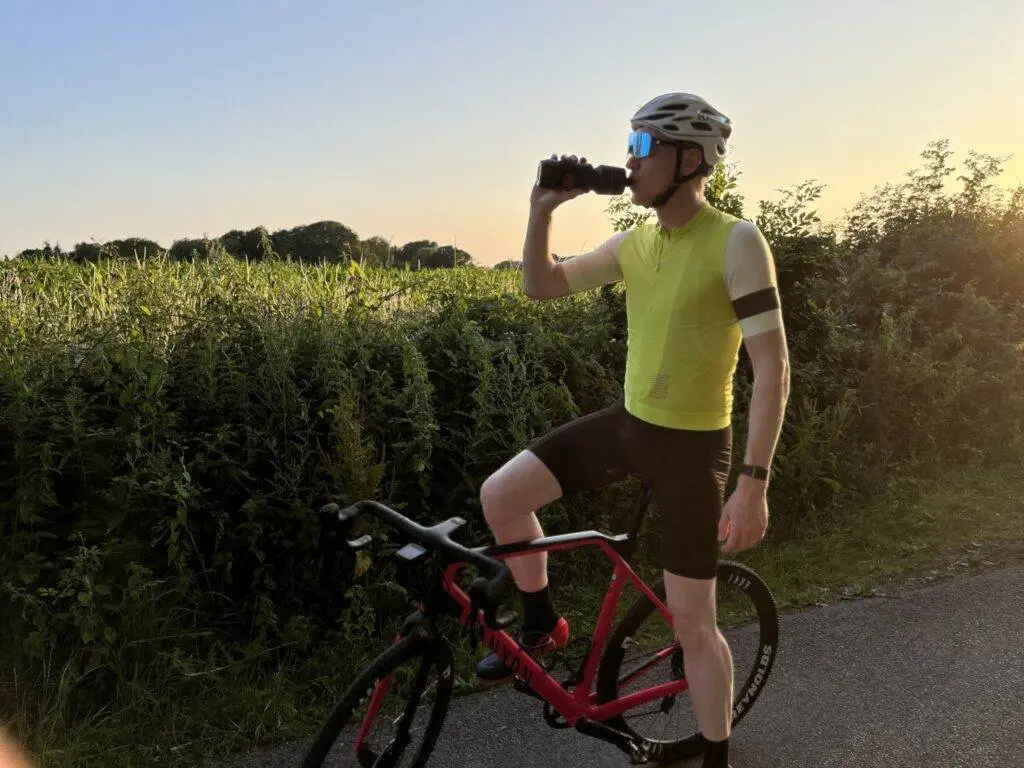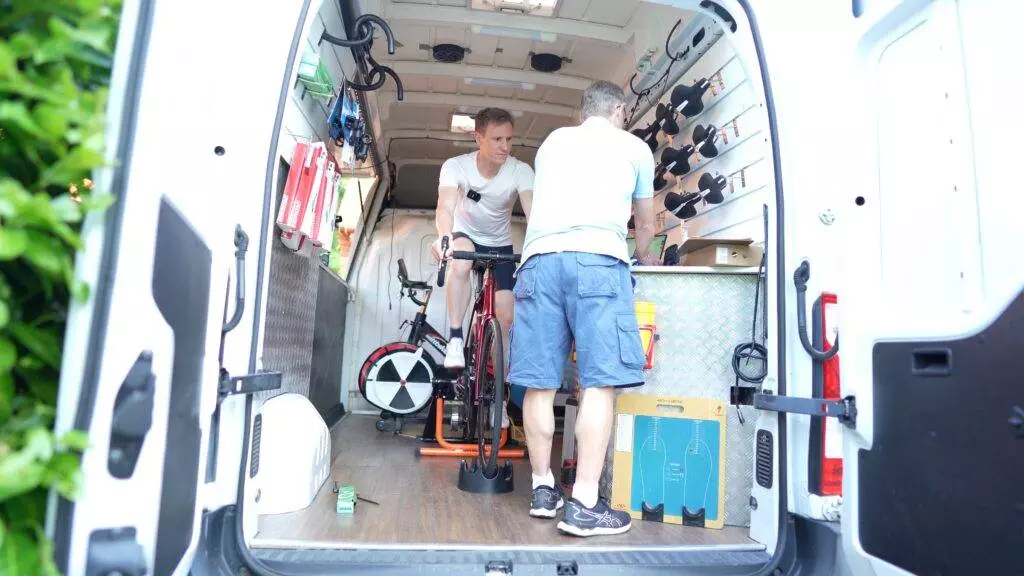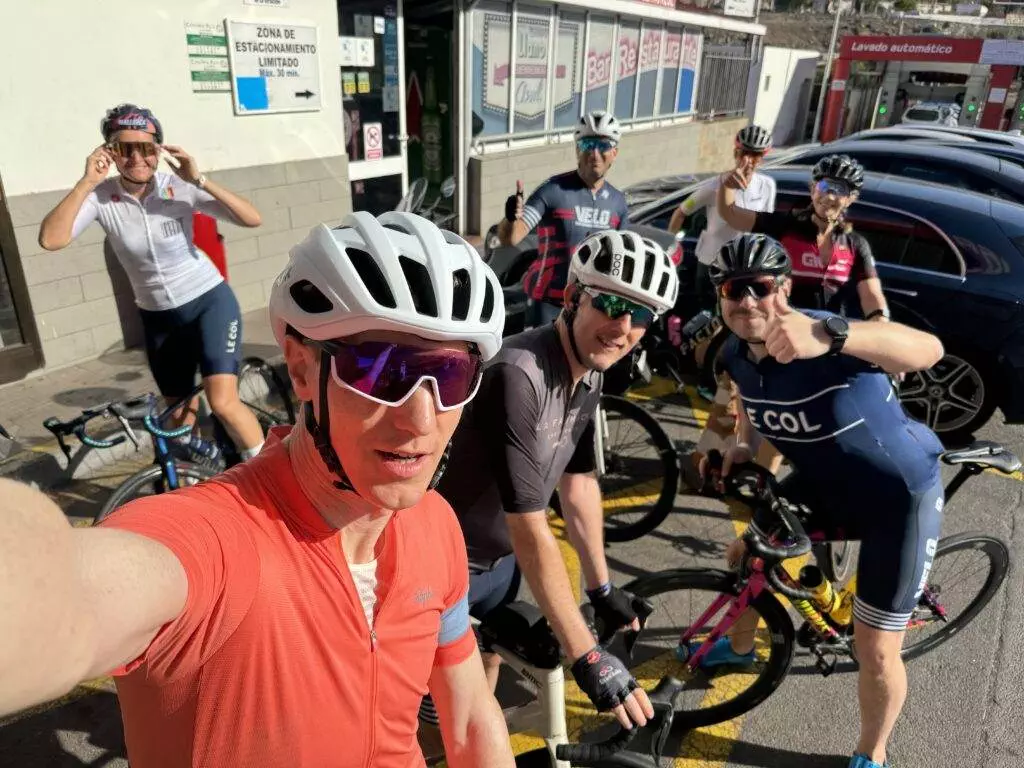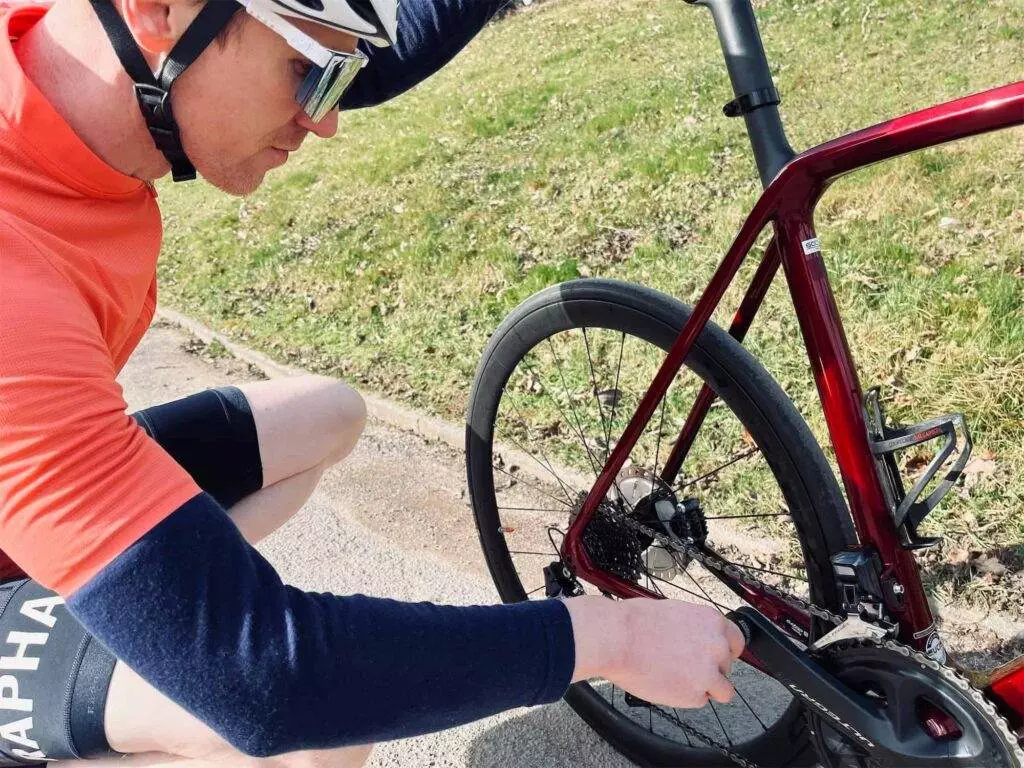Long-distance cycling means different things to different riders.
But let’s say it’s riding your bike over long distances, from 50 miles to several hundred miles.
Either way, it requires physical endurance, mental strength, and good planning.
Whether you’re doing a century ride, a multi-day tour, or just challenging yourself, long-distance cycling is a unique and rewarding experience.
In this ultimate guide, we’ll delve into expert tips, effective training routines, and essential nutritional advice to help you prepare, perform, and enjoy the ride.
Get ready to improve your cycling and achieve your long-distance goals with confidence and energy!

Benefits of Long Distance Cycling
Long-distance cycling has many benefits beyond just fitness. Here are some key advantages:
- Better Heart Health: Regular long rides make your heart stronger and improve blood flow, lowering the risk of heart disease.
- More Stamina: Long rides build your muscle endurance and help you stay active for longer periods.
- Mental Strength: Overcoming the challenges of long rides makes you mentally tougher.
- Weight Control: Cycling burns calories and helps you maintain a healthy weight.
- Adventure: Long rides let you explore new places and enjoy beautiful routes.
- Social Connections: Joining cycling groups or events helps you meet like-minded people and build a supportive community.

Getting Started: Essential Preparations
Choosing the Right Bike for Long Distance Cycling
Picking the right bike is crucial for long-distance cycling. Here are some popular options:
- Road Bikes: These are lightweight and designed for speed on smooth roads. They are great for long rides on well-maintained roads.
- Touring Bikes: These bikes are built for comfort and can carry heavy loads. They are perfect for multi-day tours and long adventures.
- Gravel Bikes: These versatile bikes can handle mixed terrain, including gravel paths and dirt roads. They offer a balance of speed and stability.
Importance of a Proper Bike Fit
A well-fitted bike makes you more comfortable and reduces the risk of injury. Here are some key points:
- Saddle Height: Adjust the saddle so your leg is almost fully extended at the bottom of the pedal stroke.
- Handlebar Position: Make sure the handlebars are at a comfortable height and distance to avoid back and shoulder strain.
- Pedal Alignment: Proper pedal alignment prevents knee pain and ensures efficient power transfer.

Essential Gear and Accessories
Wearing the right clothing and protective gear is essential for long-distance cycling. Here are some recommendations:
- Moisture-Wicking Jerseys: These keep you dry and comfortable by wicking sweat away from your skin.
- Padded Shorts: These reduce friction and provide cushioning for long rides.
- Weather-Appropriate Layers: Dress in layers to adapt to changing weather. Consider a lightweight jacket, arm warmers, and leg warmers.
- Helmet: A quality helmet is crucial for safety. Make sure it fits snugly and meets safety standards.
- Gloves: Cycling gloves provide grip, reduce vibration, and protect your hands.
- Sunglasses: Protect your eyes from UV rays, wind, and debris with a good pair of sunglasses.

Tools and Spare Parts
Being prepared for minor repairs can save you from being stranded. Here are some essential tools and spare parts to carry:
- Multi-Tool: A compact tool with various functions, including Allen wrenches, screwdrivers, and a chain tool.
- Tire Levers: These help you remove and replace tires easily.
- Spare Tubes: Carry at least two spare tubes in case of punctures.
- Mini Pump: A portable pump to inflate your tires on the go.
- Patch Kit: For quick repairs of small punctures.
Setting Realistic Goals
Assessing your current fitness level is the first step in setting realistic goals. Consider the following factors:
- Endurance: How long can you comfortably ride without feeling exhausted?
- Strength: Do you have the muscle strength to handle long climbs and challenging terrains?
- Previous Experience: Have you participated in long rides or cycling events before?
Setting SMART Goals for Cycling
Setting Specific, Measurable, Achievable, Relevant, and Timely (SMART) goals helps you stay motivated and track your progress. Here are some examples:
- Specific: “I want to complete a 100-mile ride.”
- Measurable: “I will increase my weekly mileage by 10% over the next month.”
- Achievable: “I will train five days a week, incorporating rest days.”
- Relevant: “This goal aligns with my desire to improve my endurance and participate in a century ride.”
- Timely: “I will achieve this goal within three months.”
Training for Long Distance Cycling
Developing a Structured Training Plan
Creating a balanced training schedule is essential for building endurance and avoiding burnout. Here is a sample weekly training plan:
- Monday: Rest or light recovery ride (30-45 minutes)
- Tuesday: Interval training (1-2 hours)
- Wednesday: Steady endurance ride (2-3 hours)
- Thursday: Hill repeats or strength training (1-2 hours)
- Friday: Rest or cross-training (e.g., swimming, yoga)
- Saturday: Long ride (3-5 hours)
- Sunday: Recovery ride (1-2 hours)
Incorporating Rest Days
Rest days are crucial for recovery and preventing overtraining. They allow your muscles to repair and strengthen, reducing the risk of injury. Ensure you have at least two rest days per week, and listen to your body to adjust as needed.
Building Endurance Gradually
Gradually increasing your mileage and intensity helps build endurance without risking injury. Follow the 10% rule: increase your weekly mileage by no more than 10% to allow your body to adapt. Here are some tips:
- Start Slow: Begin with shorter rides and gradually increase the distance.
- Mix It Up: Incorporate a variety of rides, including long, steady rides, interval training, and hill repeats.
- Listen to Your Body: Pay attention to signs of fatigue and adjust your training accordingly.
Avoiding Overtraining and Injuries
Overtraining can lead to injuries and burnout. Here are some strategies to avoid overtraining:
- Cross-Training: Incorporate activities like swimming, yoga, or strength training to maintain overall fitness and prevent overuse injuries.
- Proper Nutrition: Fuel your body with a balanced diet to support your training and recovery.
- Sleep: Prioritize quality sleep to aid in recovery and performance.
Pedalling Techniques and Efficiency
Maintaining a smooth and efficient pedaling form is essential for long-distance cycling. Here are some tips:
- Cadence: Aim for a cadence of 80-100 revolutions per minute (RPM) to optimize efficiency and reduce fatigue.
- Full Pedal Stroke: Engage both the push and pull phases of the pedal stroke for maximum power.
- Relaxed Upper Body: Keep your upper body relaxed and avoid gripping the handlebars too tightly.
Cadence and Pedal Stroke
Practicing proper cadence and pedal stroke can significantly improve your efficiency and performance. Here are some exercises:
- Single-Leg Drills: Practice pedaling with one leg at a time to improve your pedal stroke.
- High-Cadence Intervals: Incorporate high-cadence intervals into your training to improve your ability to maintain a steady cadence.
- Smooth Transitions: Focus on smooth transitions between the push and pull phases of the pedal stroke.
Group Riding Benefits and Tips
Joining a cycling group can provide motivation, support, and camaraderie. Here are some ways to find a group:
- Local Cycling Clubs: Many communities have cycling clubs that organize group rides and events.
- Online Communities: Websites and social media platforms offer opportunities to connect with other cyclists and find group rides.
- Bike Shops: Local bike shops often have information about group rides and events.
Group Riding Etiquette
Following group riding etiquette ensures safety and enjoyment for all participants. Here are some key points:
- Communication: Use hand signals and verbal cues to communicate with other riders.
- Steady Pace: Maintain a steady pace and avoid sudden accelerations or decelerations.
- Drafting: Ride close to the rider in front of you to reduce wind resistance, but maintain a safe distance.
- Be Predictable: Ride in a straight line and avoid sudden movements.
Nutrition and Hydration Strategies
Pre-Ride Nutrition
Fueling your body with a balanced meal before a long ride is essential for sustained energy. Here are some tips:
- Carbohydrates: Include complex carbohydrates, such as whole grains, fruits, and vegetables, to provide a steady source of energy.
- Proteins: Incorporate lean proteins, such as chicken, fish, or legumes, to support muscle function.
- Healthy Fats: Include healthy fats, such as avocados, nuts, and olive oil, for sustained energy.
During-Ride Fueling
Consuming easily digestible snacks during your ride helps maintain energy levels. Here are some recommendations:
- Energy Bars: Choose bars with a balance of carbohydrates, proteins, and fats.
- Gels and Chews: These provide quick energy and are easy to consume on the go.
- Fruits: Bananas, dates, and dried fruits are natural options that provide quick energy.
Post-Ride Recovery Nutrition
Replenishing your body with a combination of carbohydrates and proteins within 30 minutes of finishing your ride aids in muscle recovery and glycogen replenishment. Here are some ideas:
- Recovery Shake: Blend a protein powder with fruits and milk or a plant-based alternative.
- Balanced Meal: Include lean proteins, whole grains, and vegetables in your post-ride meal.
- Hydration: Drink plenty of water and consider an electrolyte drink to replace lost minerals.
Natural Fuel Options
Natural fuel options provide sustained energy without artificial additives. They are easier on the stomach and offer additional nutritional benefits. Here are some advantages:
- Nutrient-Dense: Natural ingredients are rich in vitamins, minerals, and antioxidants.
- Easier Digestion: Whole foods are generally easier to digest and less likely to cause gastrointestinal issues.
- Sustained Energy: Natural options provide a steady release of energy, preventing spikes and crashes.
Consider incorporating these natural fuel options into your long rides:
- Bananas: Rich in carbohydrates and potassium, bananas provide quick energy and help prevent cramps.
- Dates: High in natural sugars and fiber, dates offer a quick energy boost.
- Trail Mix: A mix of nuts, seeds, and dried fruits provides a balance of carbohydrates, proteins, and healthy fats.
- Homemade Energy Bars: Make your own energy bars using oats, honey, nuts, and dried fruits.
Hydration Tips for Long Rides
Hydration is key to performance and recovery. Here are some tips to stay hydrated:
- Before the Ride: Drink water regularly throughout the day leading up to your ride.
- During the Ride: Carry enough fluids and drink small amounts regularly. Aim for 16-20 ounces of water per hour.
- After the Ride: Rehydrate with water and consider an electrolyte drink to replace lost minerals.
Electrolyte Balance
Maintaining electrolyte balance is crucial, especially during long rides. Electrolytes help regulate muscle function and prevent cramps. Here are some tips:
- Electrolyte Drinks: Use electrolyte drinks or tablets to replace lost minerals.
- Salty Snacks: Include salty snacks, such as pretzels or salted nuts, to help maintain electrolyte balance.
- Monitor Signs: Pay attention to signs of electrolyte imbalance, such as muscle cramps, fatigue, and dizziness.
Mental Strategies for Long Distance Cycling
Breaking the Ride into Sections
Mentally dividing your ride into manageable sections helps you stay motivated and focused. Here are some strategies:
- Set Milestones: Identify key points along your route, such as rest stops or scenic landmarks, and use them as milestones.
- Mini-Goals: Break your ride into smaller goals, such as reaching a certain distance or time. Celebrate each achievement to stay motivated.
Staying Motivated and Focused
Keeping your mind engaged during long rides is essential for maintaining focus and motivation. Here are some tips:
- Vary Your Route: Explore new routes and scenery to keep things interesting.
- Listen to Music or Podcasts: Create a playlist or listen to podcasts to keep your mind occupied.
- Visualize Your Goals: Picture yourself completing the ride and achieving your goals. Positive visualization can boost confidence and motivation.
Overcoming Mental Fatigue
Developing mental resilience helps you overcome challenges and stay focused during long rides. Here are some techniques:
- Mindfulness Practices: Incorporate mindfulness practices, such as meditation and deep breathing, to stay present and focused.
- Positive Self-Talk: Use positive affirmations and self-talk to boost confidence and overcome negative thoughts.
- Stay Present: Focus on the present moment and avoid dwelling on past or future challenges.
Visualization and Positive Thinking
Visualization and positive thinking are powerful tools for overcoming mental fatigue. Here are some tips:
- Visualize Success: Picture yourself completing the ride and achieving your goals. Imagine the sense of accomplishment and satisfaction.
- Positive Affirmations: Use positive affirmations to reinforce your confidence and motivation. Repeat phrases like “I am strong” and “I can do this.”
Post-Ride Recovery and Maintenance
Importance of Recovery
Incorporating stretching and cool down exercises after your ride helps prevent stiffness and promotes flexibility. Here are some recommendations:
- Stretch Major Muscle Groups: Focus on stretching the muscles used during cycling, including the quadriceps, hamstrings, calves, and lower back.
- Hold Stretches: Hold each stretch for 20-30 seconds to allow the muscles to relax and lengthen.
- Cool Down Ride: Finish your ride with a 10-15 minute cool down ride at a low intensity to gradually lower your heart rate.
Rest and Sleep
Prioritizing rest and quality sleep is essential for recovery and performance. Here are some tips:
- Sleep Hygiene: Create a sleep-friendly environment by keeping your bedroom cool, dark, and quiet.
- Consistent Schedule: Maintain a consistent sleep schedule by going to bed and waking up at the same time each day.
- Relaxation Techniques: Incorporate relaxation techniques, such as deep breathing or reading, to unwind before bed.
Bike Maintenance Tips
Performing regular maintenance checks on your bike ensures it is in optimal condition. Here is a maintenance checklist:
- Clean Your Bike: Regularly clean your bike to remove dirt and debris that can cause wear and tear.
- Lubricate the Chain: Apply lubricant to the chain to reduce friction and prevent rust.
- Check Tire Pressure: Ensure your tires are properly inflated to the recommended pressure.
- Inspect Brakes: Check the brake pads and cables for wear and replace them if necessary.
- Tighten Bolts: Regularly check and tighten bolts on the handlebars, saddle, and pedals.
Common Repairs and How to Handle Them
Learning basic bike repairs can save time and prevent disruptions during your ride. Here are some common repairs and how to handle them:
- Fixing a Flat Tire: Use tire levers to remove the tire, replace the tube, and re-inflate the tire with a mini pump.
- Adjusting Brakes: Use an Allen wrench to adjust the brake pads and cables for optimal braking performance.
- Tuning Gears: Adjust the derailleur to ensure smooth shifting and prevent chain skipping.

Conclusion
Long-distance cycling requires careful preparation, structured training, proper nutrition, and mental resilience. By following these tips and strategies, you can enhance your performance and enjoy your rides more.
Remember to choose the right bike, set realistic goals, and prioritize recovery to achieve your cycling goals.
Embark on your long-distance cycling journey with confidence and enthusiasm. Every ride is an opportunity to improve, explore, and experience the joy of cycling. Stay motivated, stay safe, and enjoy the ride!
FAQs
What type of bike is best for long-distance cycling?
The best type of bike for long-distance cycling depends on your preferences and the terrain you’ll be riding on. Road bikes are ideal for smooth pavement, touring bikes are great for carrying heavy loads and handling various terrains, and gravel bikes offer versatility for mixed terrain routes.
How can I prevent fatigue during long rides?
To prevent fatigue during long rides, focus on maintaining a steady pace, staying hydrated, and fueling your body with easily digestible snacks. Incorporate rest breaks and practice proper pedaling techniques to optimize efficiency and reduce strain.
What should I eat before a long ride?
Before a long ride, fuel your body with a balanced meal that includes complex carbohydrates, lean proteins, and healthy fats. Avoid heavy or greasy foods that can cause discomfort.
Examples of pre-ride meals include oatmeal with fruits, a chicken and vegetable wrap, or a smoothie with protein powder.
How do I stay motivated during long-distance cycling?
Staying motivated during long-distance cycling involves setting milestones and mini-goals, varying your route, and keeping your mind engaged with music or podcasts. Visualization and positive self-talk can also boost confidence and motivation.
What are some natural fuel options for long rides?
Natural fuel options for long rides include bananas, dates, trail mix, and homemade energy bars. These provide a balance of carbohydrates, proteins, and healthy fats for sustained energy without artificial additives.
How important is hydration for long-distance cycling?
Hydration is crucial for long-distance cycling as it affects performance and recovery. Drink water regularly before, during, and after your ride. Use electrolyte drinks to replace lost minerals and maintain electrolyte balance.

hey, so im kinda new to the whole long-distance biking thing and was wondering what’s the best way to start training? like, should i ramp up my miles slowly or just dive in? thanks for the help!
I truly appreciated the section on nutrition and hydration strategies. It’s often overlooked but so vital for endurance sports. Well done on emphasizing its importance, Kier.
Group riding etiquette is a must-know for anyone getting into this. Had a few close calls myself when I was starting out. Good on ya for pointing it out!
The advice on pre-ride nutrition is spot on. Starting a ride properly fueled can make a huge difference. Incorporating complex carbs and lean proteins can provide sustained energy. Great point!
While I appreciate the overview on gear and accessories, I think you might have missed out on the importance of technological aids, like GPS and performance trackers. They’re game-changers for training and tracking progress.
love love love the section on breaking the ride into sections. Mental games are key to not getting overwhelmed. Thanks for sharing!
Tools and spare parts section is a lifesaver. Nothing like being 50 miles out and getting a flat with no tube. Happened to me once, never again!
Regarding pedalling techniques and efficiency, is there a significant difference in muscle engagement compared to running? I’m curious about the transition in terms of physical adaptation.
Absolutely, knowing how to signal and communicate in a group can make all the difference. Saved me more than once!
It’s so refreshing to see an emphasis on natural fuel options. Keeping it green not just in our transport but in our bodies too. Really cool point!
Ah yes, the mental strategies. Because convincing myself that I’m not exhausted after the 100th mile is just what I need. Magic.
You mention setting SMART goals, which is fine and dandy. But let’s not forget, sometimes it’s not about being smart—it’s about being stubborn and just not giving up. Can’t measure that.
Just don’t be that guy wearing headphones and wondering why everyone’s yelling, lol.